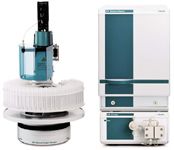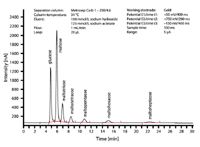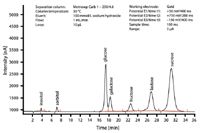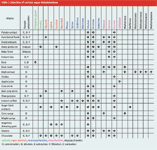Determining Carbohydrates in Essential and Nonessential Foodstuffs Using Ion Chromatography
This article describes a straightforward ion chromatographic method that uses isocratic elution and pulsed amperometric detection (PAD) to sensitively determine water-soluble polyols and sugar alcohols as well as mono-, di- and oligosaccharides in essential and nonessential foodstuffs.
Alfred Steinbach and Andrea Wille, Metrohm AG
Carbohydrates or sacccharides, also called sugars, are the most abundant organic molecules found in the biosphere. They include monosaccharides (e.g., glucose, fructose, xylose, or mannose), disaccharides (e.g., sucrose, lactose, and maltose), trisaccharides, oligosaccharides, and polysaccharides. Carbohydrates are synthesized in plants during photosynthesis using carbon dioxide, water, and the energy from sunlight. They are one of the three macronutrients (proteins and fats being the other two) that provide the human body with energy. Complex polysaccharides are structural elements in the cell walls of bacteria and plants and are stored for food or structural support. In addition, ribose and deoxyribose form part of the structural framework of RNA and DNA. Due to the widespread use and importance of carbohydrates, their determination is of considerable interest in biological, environmental, clinical and medical research. Additionally, quality control of foodstuffs assures consumers' top-quality carbohydrate supply.
The most commonly applied analytical techniques for determining carbohydrates are 1H-nuclear magnetic resonance (NMR), Fourier transform infrared spectroscopy (FT-IR), polyacrylamide gel electrophoresis (PAGE), mass spectrometry (MS) along with gas and liquid chromatography. While spectroscopic methods suffer from high instrumentation costs and need highly skilled operators, gas chromatographic methods require time-consuming derivatizations. In view of these drawbacks, high-performance anion-exchange chromatography has increasingly been used for carbohydrate determination. In strongly alkaline mobile phases, sugar anions are separated on a positively charged strong anion-exchange resin. Subtle differences in pKa values of the hydroxyl groups of the carbohydrates allow for an efficient separation of low-molecular saccharides. However, sensitive and straightforward detection of the separated carbohydrates has long been a challenge. Due to missing chromophores and fluorophores, ultraviolet and fluorescence detectors cannot be used and refractive index detection suffers from poor sensitivity and the fact that gradient elution is not applicable. Several post-column derivatization reactions have been proposed for the spectrophotometric detection of carbohydrates. However, the improved sensitivity of these methods is offset by the laborintensive and often error-prone derivatization procedure.
Since carbohydrates are electrochemically active, ampero-metric detection overcomes the mentioned shortcomings. A triple-step potential waveform referred to as pulsed amperometric detection (PAD) is applied. First a positive potential (E1) is applied to determine the target analytes, followed by a second, more positive potential (E2) for oxidative removal of any reaction products from the electrode surface. The third, negative potential (E3) reduces any surface oxide on the electrode surface. The entire three-stage process typically lasts 1 s and is continuously repeated to prevent electrode fouling. Apart from carbohydrates, PAD has proven effective for amino sugars, amino acids, biogenic amines, sulphur-containing species, alcohols, and some antibiotics.
Several applications demonstrate the potential of ion chromatography followed by pulsed amperometric detection in food and beverage samples.
Materials and Methods
Instrumentation
Chromatographic equipment:
- 871 Advanced Bioscan
- 838 Advanced IC Sample Processor
- 833 Advanced IC Liquid Handling Pump Unit
- 833 Advanced IC Liquid Handling Dialysis Unit
- 818 Advanced IC Pump

Figure 1: 871 Advanced Bioscan with 838 Advanced IC Sample Processor and 818 Advanced IC Pump.
Instrument control, data acquisition, and processing were performed by Metrodata IC Net software (Metrohm AG).
Reagents and eluents
Carbohydrates were reagent grade and purchased from Fluka (Sigma Aldrich, Buchs, Switzerland). All standard solutions and eluents were prepared with deionized water with a specific resistance higher than 18 MΩ·cm.
Example 1 — Carbohydrate determination in malt extract
Viscous or dried malt extracts are obtained from germinated barley and contain naturally present enzymes, particularly amylase, which convert starch to water-extractable sugars. Malt extracts excel in their high physiological and nutritional values. Malt is added as a nutritional supplement to the diets of infants and elderly persons. Furthermore, it is a very important intermediate ingredient in infant and pet foods, variety and party breads, instant coffee, beverages, ice creams, and pharmaceuticals, etc.
Experimental
Sample preparation of malt extracts is straightforward and only involves a 1:100 dilution. Afterwards the sample can be directly injected.
Results
Glucose, fructose, and sucrose are primarily responsible for food's sweetness. Since the latter two sugars are not present at detectable concentrations (Figure 2), malt extracts are only perceived half as sweet as mainly sucrose-containing products. Apart from glucose and maltose the investigated malt extract contains several maltooligosaccharides.

Figure 2: PAD carbohydrate chromatogram of a malt extract sample containing 593 mg/L glucose, 5642 mg/L maltose, 1029 mg/L maltotriose, 291 mg/L maltotetraose, 164 mg/L maltopentaose, 327 mg/L maltohexaose, and 97 mg/L maltoheptaose. The malt extract sample was diluted 1:100.
The observed saccharide profile of the investigated sample corresponds to the general malt composition.
Example 2 — Carbohydrate content in dairy products
In contrast to the straightforward sample preparation of soluble sugar constituents in malt extracts presented above, the analysis of protein-containing samples such as dairy products can pose severe problems when directly injected. Precipitation of the proteins fouls the column and ultimately destroys it. This can be prevented by the integration of upstream precipitation procedures such as Carrez precipitation. However, apart from the labor-intensive preparation, Carrez precipitation suffers from coprecipitation, inclusions, and enhanced sugar decomposition.
In contrast, carbohydrate separation from high-molecular proteins can be comfortably achieved via stopped-flow dialysis. This technique is based on the selective diffusion of molecules or ions from one liquid (donor or sample solution) to another (acceptor solution) via a membrane. The driving force for the transfer is the concentration gradient across the membrane. The molecular separation thresholds are generally determined by the thickness and porosity of the membrane.
Unlike in dynamic dialysis, where two solutions continuously pass through the dialysis module, in equilibrium dialysis, at least one solution is temporarily stopped until the concentration in the acceptor solution is the same as that in the donor solution. This patented stopped-flow procedure takes about 14 min and can be directly coupled to an IC setup (Figure 3). As the dialysis is performed during the recording of the previous sample's chromatogram, the overall analysis time is not prolonged.

Figure 3: Schematic diagram showing (a) inline dialysis cell and (b) coupling to the sample changer and IC unit. The photograph on the bottom left (c) shows Metrohm's patented spiral-flow dialysis cell.
Experimental
The carbohydrate content in fruit yogurt was determined according to the following procedure: Before dialysis, 10 g yogurt is dissolved in 1 L ultrapure water and the resulting solution diluted 1:10 (v/v). 10 mL of this solution is passed along the dialysis membrane by the peristaltic pump built into the 838 Advanced IC Sample Processor, while the acceptor solution remains at rest. Whereas dialyzable carbohydrates migrate from the sample stream into the acceptor solution, the high-molecular protein constituents stay on the sample side of the membrane. Finally, the acceptor solution is transferred to the sample loop.
Results
Figure 4 shows the chromatogram of a fruit yogurt dialysate with the following peaks: the polyol inositol, the sugar alcohol sorbitol, and the mono- and disaccharides glucose, galactose, fructose, lactose, and sucrose. Repetitive analyses showed no trending in peak areas, peak heights or retention times, which suggests that sample proteins did not pass the membrane. In contrast, carbohydrate recovery rates between 95 and 105% indicate quantitative permeability of the membrane for the target carbohydrates and thus the applicability of the dialysis technique.

Figure 4: PAD carbohydrate chromatogram of a fruit yogurt dialyzate containing 0.2 mg/g inositol, 0.8 mg/g sorbitol, 21.0 mg/g glucose, 7.4 mg/g galactose, 16.1 mg/g fructose, 26.5 mg/g lactose, and 77.0 mg/g sucrose.
Carbohydrate content in various food and beverage products — an overview
Carbohydrate analysis offers very far-reaching application possibilities for the analysis of beverages, foods, and sweets (Table I). Unlike the above-mentioned protein matrix, most foodstuff samples only require sample preparation methods such as comminution, dilution, extraction, sonication, and/or filtration. Table I gives an overview of the determination of various polyols, sugar alcohols as well as mono-, di-, and oligosaccharides in different foodstuffs.

Table I: Selection of various sugar determinations
The presented setup also facilitates carbohydrate analysis in plant extracts, blood, urine, pharmaceutical products, explosives, or biofuels. However, these determinations are beyond the scope of this article.
Conclusion
High-performance anion-exchange chromatography with pulsed amperometric detection using a gold working electrode can be used to determine various carbohydrates in different food matrices. Whereas most samples require no sample preparation other than extraction, comminution, dilution, or filtration; carbohydrate determination in difficult matrices can be easily solved by using Metrohm's proven dialysis technique.
References
(1) T.R.I. Cataldi, M. Angelotti, and G. Bianco, Anal. Chem., 485, 43–49, (2003).
(2) A. Meyer, C. Raba, and K. Fischer, Anal. Chem., 73, 2377–2382, (2001).
(3) P. Deepak, Food&Pack, 40, (2002).
(4) M.M. Takematsu, et. al., Quantification of carbohydrates and uronic acids in eucalyptus wood species by ion chromatography with PAD using a gold electrode, Pittcon 2008, http://products.metrohm.com (search for 8.000.6018EN).

Metrohm International Headquarters
Oberdorfstrasse 68, CH-9101 Herisau, Switzerland
tel. +41 71 353 85 04
Website: www.metrohm.com.

Analytical Challenges in Measuring Migration from Food Contact Materials
November 2nd 2015Food contact materials contain low molecular weight additives and processing aids which can migrate into foods leading to trace levels of contamination. Food safety is ensured through regulations, comprising compositional controls and migration limits, which present a significant analytical challenge to the food industry to ensure compliance and demonstrate due diligence. Of the various analytical approaches, LC-MS/MS has proved to be an essential tool in monitoring migration of target compounds into foods, and more sophisticated approaches such as LC-high resolution MS (Orbitrap) are being increasingly used for untargeted analysis to monitor non-intentionally added substances. This podcast will provide an overview to this area, illustrated with various applications showing current approaches being employed.






















